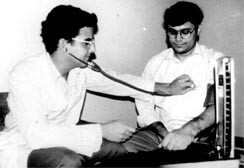Temperamental disease
 Though it is known that a person's pulse rate and blood pressure (BP) is often higher when measured in a doctor's clinic or a hospital, as compared to work or play, this phenomenon referred to as white-coat hypertension, has not received much attention. Some earlier studies have even suggested that such patients were ne6dlessly given drugs to bring the pressure down.
Though it is known that a person's pulse rate and blood pressure (BP) is often higher when measured in a doctor's clinic or a hospital, as compared to work or play, this phenomenon referred to as white-coat hypertension, has not received much attention. Some earlier studies have even suggested that such patients were ne6dlessly given drugs to bring the pressure down.
While few doctors question the existence of white-coat hypertension, there are strong disagreements among them about interpreting such data, as well as the course of treatment of such people. A study recently published by the Department of Medicine, Western Infirmary in Glasgow, US, indicates that white-coat hypertension may indeed be an early indicator of cardiovascular disease.
While conducting a trial on anti-hypertensive treatment, Stephen Glen and his colleagues, measured for 28 hours every 15 minutes the Bp as well as the cardiovascular function using echo-cardiography and oscillometry in 65 patients including 23 with normal blood pressure, 22 with white-coat hypertension and 20 with persistent hypertension. They found that patients with white-coat hypertension had cardiovascular abnormalities similar to persistently hypertensive persons. The researchers conclude that such early changes noticed in white-coat hypertensives may precede systolic dysfunction and, ultimately, the development of cardiac failure. Glen's study adds to the growing body of evidence that white-coat hypertension is not as benign as it is thought to be and should be taken more seriously.
The researchers prescribe early intervention with drug treatment. Such a treatment, they argue, may delay or prevent the development of life threatening complications. Some doctors in the US have, however, suggested that such patients be fitted with ambulatory devices that automatically record the blood pressure every 15 minutes for a day and only then decide on the course of treatment.
One study carried out last year in Copenhagen by a group led by Niels Weinberg of the Fredeoiksberg Hospital, Copenhagen, measured the BP of 352 healthy people aged 20 to 79. The Bp was continuously monitored through ambulatory devices while they were in their normal routines from sleeping to exercising. The study showed that white-coat hypertension was especially pronounced in people 60 years and older.
Weinberg's study also concludes that higher in, found in older people may result in part from an exaggerated white-coat effect. This is supported by an independent study from Italy on more than 1,511 men and women whose BP was monitored at home, in the office and in the clinic. Michael A Weber, the editor of the journal Hypertension, which published some of this research argued that the Danish and Italian studies call for a stronger advocacy of ambulatory RP monitoring in people with white-coat hypertension. Weber, who chairs the department of medicine at Brookdale Hospital in New York, says that it is important to make a clear-cut diagnosis in patients with white-coat hypertension, as the decision of the physician often determines the future of the patients.
There is, however, no universal consensus among physicians on whether such patients whose blood pressure rises in a doctor's clinic and comes back to normal when measured outside should be routinely put on anti-hypertensives.
Writing a commentary in Lancet on the study of Glen et al, Barry P McGrath of the Monash University, Clayton, Australia, argues that the key question whether patients with white-coat hypertension are a group of people at relatively low risk of cardiovascular morbidity needs to be resolved soon, and ambulatory BP monitoring is the most reliable way to do that. McGrath says that according to the current weight of evidence, white-coat hypertension probably carries an overall cardiovascular risk that is intermediate between that of sustained hypertension and normal tension. Nevertheless, he agrees with the conclusions of Glen's group that patients with white-coat hypertension need close follow-up and should not be considered as having no added cardiovascular risk.
White-coat hypertension appears to be largely unrecognised in India. It is especially important for us as several studies have shown that as many as 10 per cent of Indians may be genetically prone to heart ailments.
